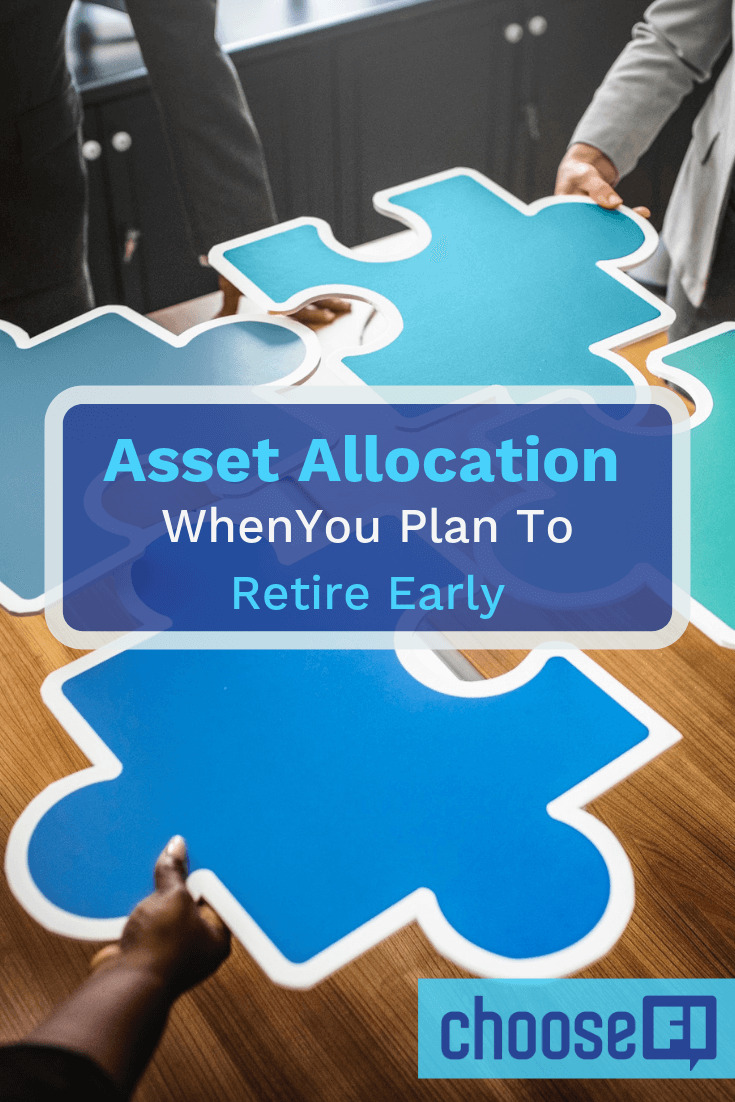Asset allocation is fundamental to successful investing. We can think of it as being an essential part of Investing 101. But is asset allocation different for those on the path to early retirement?
Absolutely.
The retire early crowd (FIRE) has two primary objectives that the traditional retirement crowd doesn’t:
- Accumulate a large retirement portfolio as quickly as possible.
- Make it last for many decades.
That radically changes the entire nature of asset allocation, at least for anyone who wants to retire early.
But before we get to that, let’s start with a brief review of the basics of asset allocation.
What Is Asset Allocation And Why Does It Matter?
Asset allocation, often better known as diversification, is an investment strategy in which you spread your portfolio across several different asset classes. In doing so, you reduce the volatility associated with any one particular asset class. That generally improves the long-term performance of your portfolio.
For example, a portfolio that holds 70% in stocks, 20% in bonds, and 10% in cash equivalents, will better weather a downturn in stocks than a portfolio that’s 100% invested in stocks.
If the market falls by 50%, and you’re 100% invested in stocks, you’ll lose 50% of your money. But if only 70% is held in stocks, a 50% stock market decline will result in only a 35% drop in your total portfolio. This happens because 30% of your portfolio is not exposed to stocks.
A typical investment portfolio is invested between three basic asset classes:
- Stocks
- Bonds or fixed income investments
- Cash or cash equivalents
Some portfolios are even more diversified, and will also add allocations in natural resources, like energy and precious metals, or real estate (generally through real estate investment trusts, or REITs).
These five general asset classes are typically found in professionally managed portfolios, including robo-advisors like M1 Finance.
If you plan to retire early, should you follow the same asset allocation pattern as most other investors?
Probably not.
Thinking Outside The Box–Why Asset Allocation Is Different When You Want To Retire Early
If you invest through a traditional investment advisor or a robo-advisor, asset allocation will be dealt with very early in the process.
At least in the case of robo-advisors, the application process will include a list of between six and 12 questions you’ll need to complete to determine your investment goals, time horizon, and risk tolerance.
More precisely, the emphasis will be heavily on establishing your risk tolerance. That relates to your emotional ability to handle serious declines in your portfolio. If you’re generally risk-averse, you’ll be very uncomfortable with significant declines, say 20% or more. In that case, your portfolio will include a lower stock allocation.
If you have a higher risk tolerance, your portfolio will include an asset allocation more heavily invested in stocks.
To get an idea of what such a questionnaire looks like you can check out the Vanguard Investor Questionnaire.
Even if you are planning to retire early, you might want to start by completing this or a similar questionnaire. It’ll provide an objective assessment of your risk tolerance.
But if early retirement is on your radar, you won’t have the luxury of relying on recommendations that will come as a result of the questionnaire.
Remember the two primary objectives of early retirement we discussed at the beginning? The solution to both will require a heavy dose of aggressive investing.
Since early retirement is by definition a very long-term lifestyle choice, you’ll need to favor growth assets like stocks in your portfolio, much more so than those who are planning for traditional retirement at 65 or 67.
There are three primary phases to investing for early retirement: the accumulation phase, the early retirement phase, and the traditional retirement age phase. Let’s examine the asset allocations you’ll need for each.
1. In The Accumulation Phase
Early Retirement Objective #1: Accumulate a large retirement portfolio as quickly as possible.
This objective is mission-critical if you want to retire early. The entire process relies on your ability to get this part of your retirement planning right.
Let’s start with this fundamental reality: the average return on stocks as measured by the S&P 500 has been about 10% from 1928 until now. By contrast, the current yield on the 10-year US Treasury note is hovering around 2.65%.
If you’re a conservative investor, you might split your portfolio equally between an S&P 500 index fund and a 10-year Treasury note. That would give you a blended average annual return of about 6.33%.
If you’re 25 years old, and you plan on retiring at 45 by saving $19,500 per year (the 401(k) maximum employee contribution), an average annual rate of return of 6.33% will give you a portfolio of $743,292.
Since you probably need at least $1 million to retire in 20 years, that kind of return isn’t going to work for you.
But let’s say instead you decide to invest 90% in stocks and 10% in 10-year Treasury notes. That will give you an average annual return of 9.27%.
Again, if you’re 25, and planning to retire at 45, saving $19,500 per year with an average annual return of 9.27% will give you a portfolio of $1,028,365. There you go!
The moral of the story: If you plan to retire early, your portfolio will need to be invested almost entirely in stocks during the accumulation phase. A larger allocation in bonds or cash equivalents will not enable you to reach your goal.
Related: How To Create An Investment Policy Statement
2. In The Early Retirement Phase
With traditional retirement planning, you’ll gradually increase your bond and cash equivalent portfolio allocations, and reduce stock holdings as you move close to retirement. The basic concept is to reduce portfolio volatility as you approach and reach retirement age.
If you plan to retire early, you won’t have that “luxury”.
Retiring at 45 or 50, or even 55, is radically different than retiring at 65 or 70. The mathematical reality is that you’ll have more decades to provide for when you retire early.
For example, if you retire at 65, you may need your portfolio to provide for you for 20 years. But if you retire 45, it’ll have to do the job for at least 40. And if you have a family history of living much longer than the average person, you may need your portfolio to cover the next 50 years.
That’s a daunting task, and it won’t be accomplished by using traditional retirement asset allocation methods.
While you may be able to reduce your exposure to stocks somewhat once you retire, you’ll still need to maintain the vast majority of your portfolio in equities.
Crunching the Numbers
Let’s start with the safe withdrawal rate. It’s just a theory, but it has a lot of critical support. It holds that if you withdraw 4% per year from a well-diversified portfolio, you’ll never run out of money.
To make the 4% figure work, you’ll actually have to earn substantially more, at least on an average basis.
Inflation is the main culprit here. In recent years it’s been running around 2% per year. But the longer-term average is more like 3% (over the past 30 to 40 years). To be able to cover inflation and still withdraw 4% per year, you’ll have to have an average annual rate of return of 7% on your portfolio.
That would require a portfolio mix of roughly 60% stocks, and 40% bonds.
But if you’re going to retire early, simply matching inflation may not be sufficient. You’ll almost certainly want to grow your portfolio in real terms.
An annual return of 8% will give you 4% for living expenses, 3% to cover inflation and 1% real growth. To achieve that, you’ll need a portfolio mix of 75% stocks and 25% bonds.
That will increase the real value of your portfolio by more than 20% over the next 20 years, giving you more options as you get older.
And if you want a 9% return, which will provide 4% for living expenses, 3% to cover inflation, and 2% real growth, you’ll have to stay with a mix of 90% stocks and 10% bonds.
That will increase the real value of your portfolio by well over 40% over the next 20 years, giving you even more options.
The bottom line is that once you reach your early retirement age, you’ll need to remain consistently and heavily invested in stocks.
3. When You Reach Retirement Age
Fearing an inability to recover major losses from a bear market, most investors get much more conservative once they reach traditional retirement age. That makes sense, but at the same time moving all your money into safe, interest-bearing assets is akin to committing financial suicide.
Consider the following facts:
- You’ll probably still need to withdraw at least 4% per year from your retirement portfolio, though the start of Social Security benefits may reduce this percentage somewhat.
- There are currently no relatively safe, fixed-income investments paying anywhere near 4% per year.
- Inflation doesn’t stop once you retire, so you’ll still need to earn a sufficient return to cover it.
- You may continue to want to increase the value of your portfolio in real terms.
When you add up all these factors, it means you will continue to be dependent on stocks even once you reach traditional retirement age.
For example, as discussed in the previous section, you’ll need to earn at least 7% on your portfolio to both provide for living expenses and cover inflation. That will require a 60/40 mix of stocks and bonds. And if you want to continue to grow your portfolio in real terms, the stock allocation will need to be even higher.
But hopefully, by the time you reach traditional retirement age, you’ll be sufficiently comfortable with the risks and rewards of stocks that continuing to maintain a majority position in your portfolio will occupy a comfortable space in your investment psyche.
The Proper Asset Allocation Strategy Of Early Retirement Is To Never Outlive Your Money
Remember at the very beginning we said Early Retirement Objective #2 is make it (your retirement portfolio) last for many decades? We can summarize that as never outlive your money.
That’s the greatest fear of anyone who ever retires. But it’s even more acute for anyone who retires early. Because you will have many more years in retirement than the average person, your portfolio will need to last longer.
There’s no way to accomplish that goal by playing it safe. Interest-bearing investments simply don’t provide enough income, and they haven’t in several decades.
If you plan to retire early, you’ll be more dependent on stocks than previous generations of retirees, and even those who will be waiting for traditional retirement age.
Yes, it’s a riskier way to invest than loading up your portfolio with bonds and other interest-bearing investments. But it’s the price you’ll have to pay to retire early. Embrace it, and make it work in your favor.
Related Articles
- Why Investing Conservatively Is Better
- M1 Finance–Complete Free Automated Investing
- Where Should You Invest? How To Determine Your Asset Allocation




